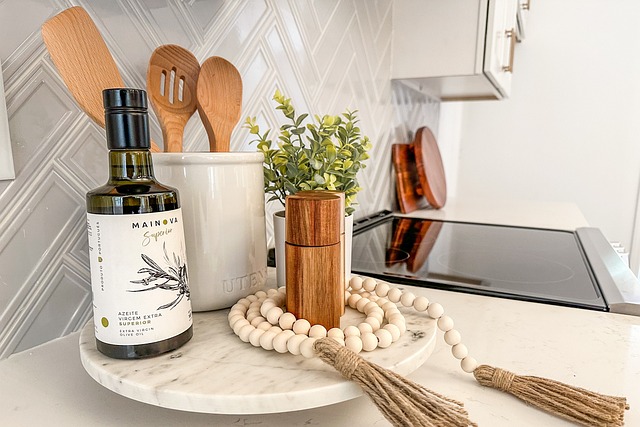Lighting and appliance choices significantly impact a kitchen's energy consumption. Upgrading to LED bulbs, strategic window placement, and eco-friendly appliances reduces energy use and costs. Light-colored finishes enhance natural light, while motion sensors optimize artificial lighting. These green kitchen design principles contribute to sustainability, lower utility bills, and improved indoor comfort.
“Transform your kitchen into a beacon of energy efficiency with a strategic remodel focused on natural light and eco-conscious choices. This article guides you through the process of creating an energy-efficient space by exploring the impact of lighting on energy consumption and offering practical solutions. Discover the benefits of light-colored finishes for enhanced natural light reflection, delve into eco-friendly kitchen appliance options, and unlock strategies for incorporating low-energy lighting. Embrace a sustainable kitchen renovation with our tips, from countertops to ceilings, and join the movement towards a greener home.”
Understanding the Impact of Lighting on Energy Consumption in Kitchens
Lighting plays a pivotal role in a kitchen’s energy consumption. In the context of a kitchen remodel focused on energy efficiency, understanding how lighting impacts energy use is crucial. Kitchens, often bustling hubs of activity, can significantly contribute to a home’s overall energy bill due to their reliance on artificial lighting. Traditional incandescent bulbs, for instance, convert much of their energy into heat rather than light, making them inefficient.
A kitchen remodel aimed at eco-friendliness and sustainability should consider low-energy lighting alternatives. LED (Light Emitting Diode) bulbs, a popular choice for green kitchen renovations, consume up to 75% less energy than incandescent bulbs while offering longer lifespans. This simple upgrade can lead to substantial energy savings over time. Additionally, incorporating natural light through strategic window placement and light tubes can further reduce the need for artificial lighting during daylight hours, contributing to a more energy-efficient and cost-effective kitchen environment.
Benefits of Light-Colored Finishes for Enhanced Natural Light Reflection
Choosing light-colored finishes in your kitchen remodel can significantly enhance natural light reflection, making it a smart move for both aesthetics and energy efficiency. Light-toned surfaces like pale cabinets, countertops, and backsplashes act as canvases that bounce sunlight around the space, creating an airier and brighter ambiance. This is particularly beneficial during the day when natural light is abundant, reducing the need for artificial lighting and resulting in lower energy consumption.
In the context of an eco-friendly kitchen upgrade, this simple design choice can contribute to a sustainable kitchen renovation by minimizing electricity usage. Additionally, combining these finishes with energy-saving kitchen appliances and low-energy lighting fixtures, such as LED lights, further optimizes energy efficiency. This approach aligns with the growing trend of green kitchen remodeling, where functionality meets environmental responsibility.
Eco-Friendly Alternatives: Choosing Sustainable Kitchen Appliances
When planning a kitchen remodel focused on energy efficiency, one often overlooked yet significant aspect is selecting sustainable kitchen appliances. Eco-friendly alternatives offer not just environmental benefits but can also contribute to lower utility bills and improved indoor comfort. Opting for energy-saving kitchen appliances is a crucial step towards achieving an eco-friendly kitchen renovation.
Incorporating low-energy lighting, such as LED fixtures, into your design is a simple yet effective way to reduce energy consumption. Additionally, investing in energy-efficient models for major appliances like refrigerators, dishwashers, and ovens can significantly decrease the kitchen’s carbon footprint. Many modern brands now offer environmentally conscious options, ensuring that style and sustainability can coexist seamlessly in a green kitchen remodeling project.
Strategies for Incorporating Low-Energy Lighting in Your Kitchen Remodel
When planning a kitchen remodel focused on energy efficiency, strategic use of low-energy lighting is key. Consider replacing traditional incandescent bulbs with LED lights, which are highly efficient and long-lasting. Integrate under-cabinet LED strips to illuminate work surfaces while keeping energy consumption low. Additionally, install dimmer switches to adjust light levels according to your needs, thereby further reducing electricity usage.
For an eco-friendly kitchen upgrade, explore natural lighting solutions like skylights or larger windows. These not only enhance the aesthetic appeal of your space but also minimize the need for artificial lighting during daylight hours. Pair these with motion sensors or timers on overhead lights to ensure energy savings without compromising functionality. Opting for energy-saving kitchen appliances and incorporating low-energy lighting into your sustainable kitchen renovation will contribute significantly to a greener, more efficient living environment.
Tips for a Green Kitchen Renovation: From Countertops to Ceilings
When undertaking a kitchen remodel with an eye toward energy efficiency and sustainability, every detail counts. Start with eco-friendly kitchen upgrades like choosing light-colored finishes to reflect natural light—a simple yet powerful strategy to reduce reliance on artificial lighting. This approach not only saves energy but also creates a brighter, more inviting space.
For a truly green kitchen renovation, consider low-energy lighting options and energy-saving kitchen appliances. Opting for LED bulbs and efficient fixtures can significantly lower your energy consumption. Additionally, upgrade countertops to materials that offer better light reflection, ensuring your kitchen stays well-lit even during shorter days or power outages.
In conclusion, a kitchen remodel focused on energy efficiency can significantly reduce utility bills and environmental impact. By combining light-colored finishes to maximize natural light, choosing eco-friendly appliances, and incorporating low-energy lighting solutions, you can create a sustainable and stylish kitchen. These strategies not only benefit the planet but also enhance your daily experience in one of the most important spaces in your home.
